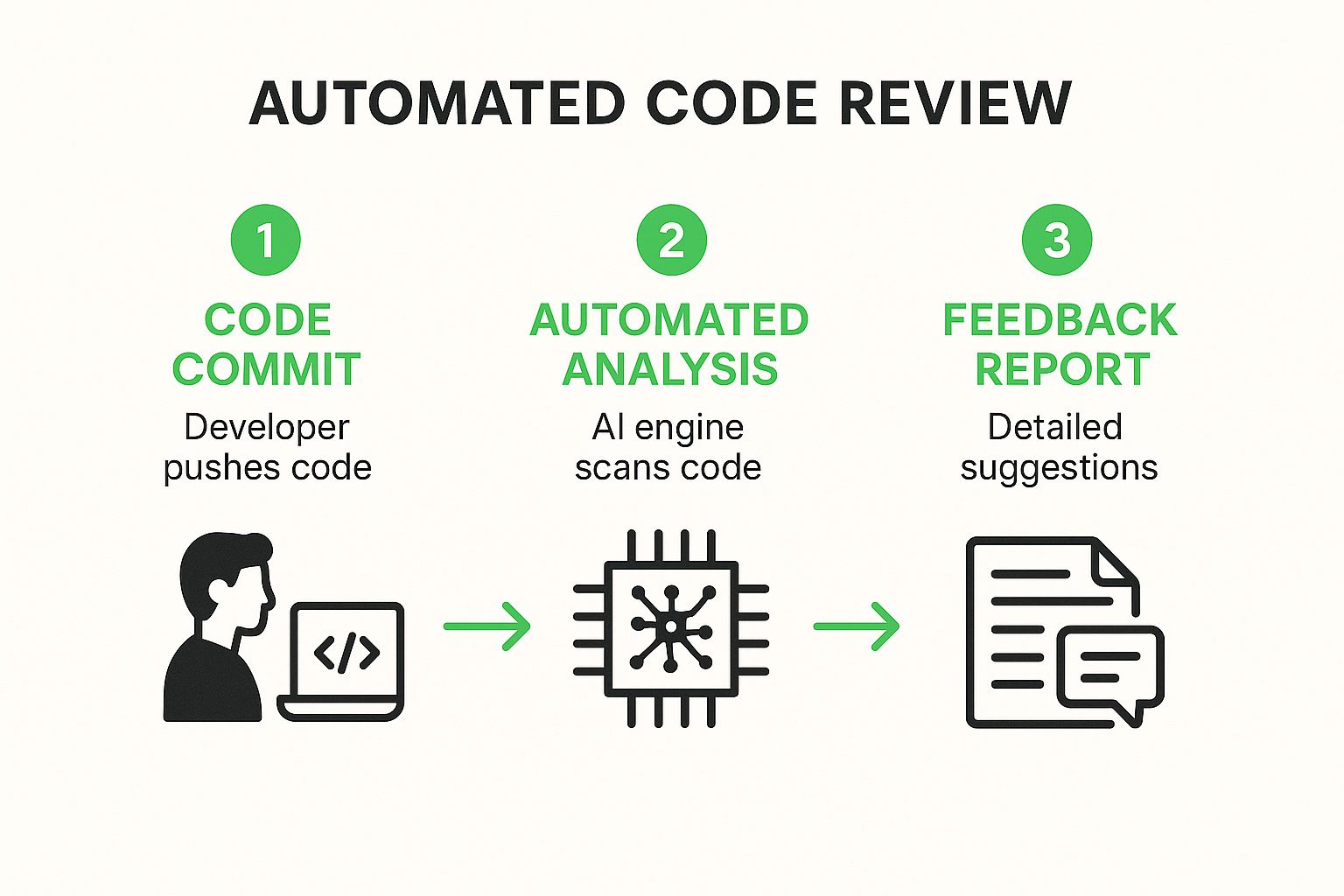Transform your development cycle with automated code reviews. Learn how to boost code quality, accelerate delivery, and empower your team with the right tools.
At its core, an automated code review is pretty simple: it’s software that checks your source code for problems without a human having to get involved. Think of it as a first-pass quality check that flags potential bugs, stylistic slip-ups, and security holes on the fly.
This process gives developers instant feedback right when they need it. Instead of waiting hours or days for a manual review, they get immediate pointers, which keeps the whole development cycle moving at a much faster clip.

For a long, long time, code review was a purely human ritual. A developer would grind out a new feature, push their code, and then… wait. Eventually, a senior engineer, already juggling their own mountain of tasks, would have to carve out time to read through every single line.
This old-school approach, while crucial for quality, was a legendary bottleneck. Everything hinged on the reviewer’s availability, their mood, and how much coffee they’d had that day. The process was riddled with inconsistency. One person might obsess over formatting, while another would only hunt for logic errors. Code quality became a lottery, entirely dependent on who was on review duty.
The move to automated code reviews wasn’t about putting developers out of a job. It was about giving them a tireless, perfectly objective assistant.
Imagine a master woodworker who delegates the repetitive, mind-numbing work—like sanding boards or measuring identical cuts—to a precise machine. That frees them up to focus on the artistry and complex joinery that actually requires their skill. That’s what automation does for developers.
It excels at the very things that drain human focus. It can relentlessly check for:
By taking these tedious checks off the table, automation lets developers pour their brainpower into what really matters: elegant architecture, solving tricky problems, and building out the core logic of the software.
This evolution from manual peer inspection to smart tooling is a massive shift in how we build software. Before these tools became mainstream, code reviews were slow and prone to human error, especially as projects got bigger. It was around the early 2020s that we saw machine learning and sophisticated rule-based systems really start to change the game. You can explore more trends in code review automation to see just how far this tech has come.
This isn’t just a simple tool upgrade; it’s a change in philosophy. It’s an acknowledgment that human attention is a precious, finite resource that should be aimed at high-impact work. For any modern engineering team that cares about speed, quality, and the ability to scale, automated code reviews are no longer a nice-to-have. They’re a flat-out necessity.
Tired of manual documentation? Discover how DocuWriter.ai uses AI to automatically generate comprehensive, accurate code documentation, freeing up your developers to focus on what they do best—building great software.

Bringing automated code reviews into your workflow is like giving your development team a superpower. It completely changes how teams function, shifting the culture away from waiting around and fixing things later to one of proactive, continuous improvement. And this isn’t just a theoretical boost—it leads to real, measurable wins in speed, quality, and even how happy your team is.
Think of it as the ultimate spell-checker for developers. A writer doesn’t hand their draft to a human editor to find basic typos; they run a spell-check first. This frees up the editor to focus on what really matters: the story’s flow, its clarity, and its overall impact. Automation does the exact same thing for code, catching the straightforward mistakes so human reviewers can sink their teeth into the complex logic and architectural decisions.
The most immediate payoff from automation is pure speed. Manual reviews are famous for being bottlenecks. A pull request can just sit there for hours, sometimes even days, waiting for a senior developer to carve out some time to look at it. In fact, GitLab’s research found that these review delays are the third biggest cause of developer burnout.
When you automate that initial feedback loop, developers get insights in minutes, not days. This lets them iterate on their changes right away while the code is still fresh in their minds. That rapid back-and-forth dramatically shortens the time from a commit to a deployment, helping teams ship features faster and with way more predictability.
Let’s be honest: human reviewers are inconsistent. One person might be laser-focused on performance, another on naming conventions, and a third might miss both because they’re just looking at the overall logic. This natural human variability leads to a real patchwork of quality across the codebase.
Automated tools, on the other hand, are relentlessly consistent. They apply the exact same set of rules to every single line of code, every single time, without fail. This creates a solid, uniform quality baseline that every developer has to meet before their code even gets considered for merging.
Over time, this consistency has a compounding effect, resulting in a codebase that’s easier to maintain, more predictable, and a whole lot less buggy. It guarantees that no matter who wrote the code or who happens to be on vacation, your quality standards never take a hit.
Finding and fixing security vulnerabilities is way cheaper and easier when you catch them early. If you wait until the QA phase—or worse, after the code is already in production—you’re setting yourself up for a potential disaster.
Automated code reviews bake security scanning right into the daily development workflow. This approach, often called “shifting left,” turns security from a reactive afterthought into a proactive part of the coding process itself.
These tools are constantly on the lookout for common security risks, including:
By catching these problems right at the pull request stage, teams can stop vulnerabilities from ever making it into the main branch. To see just how powerful this shift is, it’s worth looking into how AI in software development redefining DevOps is helping build more resilient systems from the very beginning. This proactive security mindset doesn’t just make your product safer; it also teaches developers about secure coding practices in real time.
Are manual documentation processes slowing your team down? DocuWriter.ai uses AI to generate crystal-clear code documentation automatically, so your developers can focus on innovation.
Weaving an automated code review tool into your development process isn’t some massive, complicated overhaul. Think of it more like adding a super-efficient gatekeeper to the workflow you already have. The whole point is to make quality checks a seamless, automatic part of your Continuous Integration/Continuous Deployment (CI/CD) pipeline—not another manual roadblock that slows everyone down.
This integration becomes the first line of defense for your codebase. It works by listening for specific triggers in your version control system, which is almost always the creation of a new pull request (PR) or merge request (MR). The moment a developer pushes their code and opens a PR, the system jumps into action, analyzing the changes against a set of rules you’ve defined. No human has to lift a finger.
The feedback loop is designed to feel completely natural. Instead of cluttering up your inbox or creating tickets in a separate system, the best tools post their findings directly in the pull request as comments. It feels just like a human teammate leaving a suggestion, keeping the entire conversation about the code right where it belongs.
The process is built for speed, giving developers feedback almost instantly while the code is still fresh in their minds. This simple, three-step flow is the powerhouse behind most automated code reviews.

The idea is simple: catch problems early and automatically. By slotting this check right into the pipeline, teams guarantee that no code gets merged without hitting a consistent quality bar. This automated vetting takes a huge mental load off your human reviewers, freeing them up to focus on the tricky stuff, like architecture and business logic. To see a more detailed breakdown, check out our guide on the fundamentals of automatic code review.
Let’s take a look at how this new workflow stacks up against the old way of doing things.
The table below breaks down the key differences between a traditional, manual review process and a modern, automated one. You can see pretty quickly where the time savings and consistency improvements come from.
Ultimately, automation doesn’t replace human reviewers—it empowers them. By handling the repetitive, predictable checks, it allows developers to spend their valuable time on the creative and strategic parts of the job.
Getting started is usually pretty painless. It just takes a few quick configuration steps inside your version control platform (like GitHub, GitLab, or Bitbucket) and the review tool.
The effect on your development pipeline is almost immediate. With an AI review tool running, a huge chunk of pull requests can be handled without any human oversight. One report discovered that roughly 80% of pull requests required no human comment at all, a massive win for efficiency.
These numbers show a clear shift away from tedious manual reviews. It’s not just about speed; it’s about building more resilient and maintainable code. This efficiency frees up your senior developers to think about big-picture strategy instead of nitpicking code style. You can get the full story by reading the report on the state of AI in code quality.
Is your team burdened by the endless task of writing and updating documentation? DocuWriter.ai uses advanced AI to automate the creation of code and API documentation, ensuring it’s always accurate and up-to-date.
Choosing an automated code review tool isn’t about grabbing the one with the most bells and whistles. It’s about finding a tool that actually solves your team’s biggest headaches and fits neatly into your existing tech stack and workflow.
If you choose poorly, you’ll end up with more noise than signal. That just means frustrated developers and a bogged-down pipeline. Not all automation is good automation.
The market is full of tools, each built to tackle a specific piece of the code quality puzzle. Thinking about them in categories helps make sense of what they do and where they belong in your process. A solid strategy usually involves mixing and matching a few of these, letting each one play to its strengths.
The first step to making a smart choice is understanding the main types of review tools out there. Each one specializes in a different kind of analysis, from basic style checks all the way to deep security scans.
Here’s a simple breakdown of the most common categories:
The move toward AI-powered tools is happening fast. As of 2025, a massive 82% of developers are already using AI-assisted coding tools daily or weekly. Even more telling, 59% are running three or more of them at the same time.
And with 65% of developers saying AI touches at least a quarter of their codebase, it’s obvious this kind of intelligent automation is becoming standard practice. You can dig into more of these trends in the full report on the state of AI code quality.
Once you know the categories, you need a no-nonsense checklist to size up the actual tools. The right one will slide right into your workflow, give feedback that’s actually useful, and make your developers’ lives easier—not harder.
Make sure to ask these critical questions while you’re looking:
By keeping these categories and questions in mind, you can find an automated code review tool that becomes a true asset—something that genuinely improves code quality and helps your team move faster.
Is your team burdened by the endless task of writing and updating documentation? DocuWriter.ai uses advanced AI to automate the creation of code and API documentation, ensuring it’s always accurate and up-to-date.

Simply installing an automated code review tool is just the start. The real magic happens when you weave it into your team’s culture and daily habits. If you don’t have a smart strategy, even the most powerful tool can become a nuisance, burying your developers in a landslide of low-priority notifications. The goal is to make automation a trusted partner, not just more noise.
This means you have to get your hands dirty and move beyond the default settings. You need a configuration that actually reflects what your team cares about. Think of it like tuning a guitar. Out of the box, it might make a sound, but a musician dials it in to get it just right. A well-tuned ruleset does the same, making sure the tool flags what truly matters while letting the small stuff slide.
The fastest way to get developers to ignore a new tool? Drown them in “alert fatigue.” When every tiny style issue triggers a notification, the critical alerts—like major security flaws—get lost in the shuffle. The trick is to start small and focus on the big wins first.
Begin by flipping on the rules that catch undeniable problems:
Once your team gets used to this baseline and starts seeing the value, you can gradually roll out more rules for stylistic preferences or team conventions. This phased approach builds trust and makes sure the feedback stays helpful and actionable.
Automated feedback should be the absolute minimum standard for quality. It creates a consistent floor that every single piece of code has to meet before a human reviewer even lays eyes on it.
This frees up your senior developers to stop nitpicking about comma placement and instead focus their brainpower on what machines can’t judge—tricky architectural decisions, the soundness of business logic, or the overall elegance of a solution.